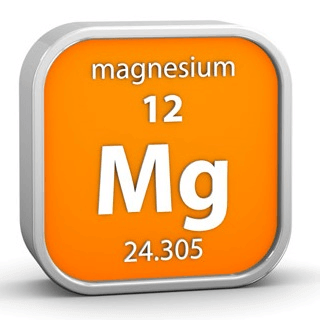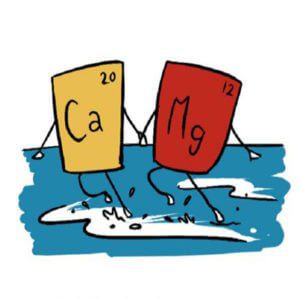

- Occurrence and Significance
Copper (Cu) is the first element in Group IB in the periodic table; it has an atomic number of 29, an atomic weight of 63.54, and valences of 1 and 2. The average abundance of Cu in the earth’s crust is 68 ppm; in soils it is 9 to 33 ppm; in streams it is 4 to 12 μg/L; and in groundwater it is <0.1 mg/L. Copper occurs in its native state, but is also found in many minerals, the most important of which are those containing sulfide compounds (e.g., chalcopyrite), but also those with oxides and carbonates. Copper is widely used in electrical wiring, roofing, various alloys, pigments, cooking utensils, piping, and in the chemical industry. Copper salts are used in water supply systems to control biological growths in reservoirs and distribution pipes and to catalyze the oxidation of manganese. Copper forms a number of complexes in natural waters with inorganic and organic ligands. Among the common aqueous species are Cu2+, Cu(OH)2, and CuHCO3+. Corrosion of copper-containing alloys in pipe fittings may introduce measurable amounts of copper into the water in a pipe system.
Copper is considered an essential trace element for plants and animals. Some compounds are toxic by ingestion or inhalation. The United Nations Food and Agriculture Organization recommended maximum level for irrigation waters is 200 μg/L. Under the lead-copper rule, the U.S. EPA drinking water 90th percentile action level is 1.3 mg/L.
- Selection of Method
The atomic absorption spectrometric methods (Sections 3111B and C), the inductively coupled plasma methods (Sections 3120 and 3125), and the neocuproine method (3500-Cu.B) are recommended because of their freedom from interferences. The electrothermal atomic absorption method (Section 3113B) also may be used with success with an appropriate matrix modifier. The bathocuproine method (3500-Cu.C) may be used for potable waters.
- Sampling and Storage
Copper ion tends to be adsorbed on the surface of sample containers. Therefore, analyze samples as soon as possible after collection. If storage is necessary, use 0.5 mL 1 + 1 HCl/100 mL sample, or acidify to pH <2 with HNO3, to prevent this adsorption.
Neocuproine Method
- General Discussion
- Principle: Cuprous ion (Cu+) in neutral or slightly acidic solution reacts with 2,9-dimethyl-1,10-phenanthroline (neocuproine) to form a complex in which 2 moles of neocuproine are bound by 1 mole of Cu+ ion. The complex can be extracted by a number of organic solvents, including a chloroform-methanol (CHCl3-CH3OH) mixture, to give a yellow solution with a molar absorptivity of about 8000 at 457 nm. The reaction is virtually specific for copper; the color follows Beer’s law up to a concentration of 0.2 mg Cu/25 mL solvent; full color development is obtained when the pH of the aqueous solution is between 3 and 9; the color is stable in CHCl3-CH3OH for several days.
The sample is treated with hydroxylamine-hydrochloride to reduce cupric ions to cuprous ions. Sodium citrate is used to complex metallic ions that might precipitate when the pH is raised. The pH is adjusted to 4 to 6 with NH4OH, a solution of neocuproine in methanol is added, and the resultant complex is extracted into CHCl3. After dilution of the CHCl3 to an exact volume with CH3OH, the absorbance of the solution is measured at 4571 nm.
- Interference: Large amounts of chromium and tin may interfere. Avoid interference from chromium by adding sulfurous acid to reduce chromate and complex chromic ion. In the presence of much tin or excessive amounts of other oxidizing ions, use up to 20 mL additional
hydroxylamine-hydrochloride solution.
Cyanide, sulfide, and organic matter interfere but can be removed by a digestion procedure.
- Minimum detectable concentration: The minimum detectable concentration, corresponding to 0.01 absorbance or 98% transmittance, is 3 μg Cu when a 1-cm cell is used and 0.6 μg Cu when a 5-cm cell is used.
- Apparatus
- Colorimetric equipment: One of the following is required:
1) Spectrophotometer, for use at 4571 nm, providing a light path of 1 cm or longer.
2) Filter photometer, providing a light path of 1 cm or longer and equipped with a narrow-band violet filter having maximum transmittance in the range 450 to 460 nm.
- Separatory funnels, 125-mL, Squibb form, with glass or TFE stopcock and stopper.
- Reagents
- Redistilled water, copper-free: Because most ordinary distilled water contains detectable amounts of copper, use redistilled water, prepared by distilling singly distilled water in a resistant-glass still, or distilled water passed through an ion-exchange unit, to prepare all
reagents and dilutions.
- Stock copper solution: To 200.0 mg polished electrolytic copper wire or foil in a 250-mL conical flask, add 10 mL water and 5 mL conc HNO3. After the reaction has slowed, warm gently to complete dissolution of the copper and boil to expel oxides of nitrogen, using precautions to avoid loss of copper. Cool, add about 50 mL water, transfer quantitatively to a 1-L volumetric flask, and dilute to the mark with water; 1 mL = 200 μg Cu.
- Standard copper solution: Dilute 50.00 mL stock copper solution to 500 mL with water; 1.00 mL = 20.0 μg Cu.
- Sulfuric acid, H2SO4, conc.
- Hydroxylamine-hydrochloride solution: Dissolve 50 g NH2OH⋅HCl in 450 mL water.
- Sodium citrate solution: Dissolve 150 g Na3C6H5O7⋅2H2O in 400 mL water. Add 5 mL NH2OH⋅HCl solution and 10 mL neocuproine reagent. Extract with 50 mL CHCl3 to remove copper impurities and discard CHCl3 layer.
- Ammonium hydroxide, NH4OH, 5N: Dilute 330 mL conc NH4OH (28-29%) to 1000 mL with water. Store in a polyethylene bottle.
- Congo red paper, or other pH test paper showing a color change in the pH range of 4 to 6.
- Neocuproine reagent: Dissolve 100 mg 2,9-dimethyl-1,10-phenanthroline hemihydrate*#(106) in 100 mL methanol. This solution is stable under ordinary storage conditions for a month or more.
- Chloroform, CHCl3: Avoid or redistill material that comes in containers with metal-lined caps.
- Methanol, CH3OH, reagent grade.
- Nitric acid, HNO3, conc.
- Hydrochloric acid, HCl, conc.
- Procedure
- Preparation of calibration curve: Pipet 50 mL water into a 125-mL separatory funnel for use as a reagent blank. Prepare standards by pipetting 1.00 to 10.00 mL (20.0 to 200 μg Cu) standard copper solution into a series of 125-mL separatory funnels, and dilute to 50 mL with water. Add 1 mL conc H2SO4 and use the extraction procedure given in ¶ 4b below.
Construct a calibration curve by plotting absorbance versus micrograms of copper.
To prepare a calibration curve for smaller amounts of copper, dilute 10.0 mL standard copper solution to 100 mL. Carry 1.00-to 10.00-mL volumes of this diluted standard through the previously described procedure, but use 5-cm cells to measure absorbance.
- Treatment of sample: Transfer 100 mL sample to a 250-mL beaker, add 1 mL conc H2SO4 and 5 mL conc HNO3. Add a few boiling chips and cautiously evaporate to dense white SO3 fumes on a hot plate. If solution remains colored, cool, add another 5 mL conc HNO3, and again evaporate to dense white fumes. Repeat, if necessary, until solution becomes colorless.
Cool, add about 80 mL water, and bring to a boil. Cool and filter into a 100-mL volumetric flask. Make up to 100 mL with water using mostly beaker and filter washings.
Pipet 50.0 mL or other suitable portion containing 4 to 200 μg Cu, from the solution obtained from preliminary treatment, into a 125-mL separatory funnel. Dilute, if necessary, to 50 mL with water. Add 5 mL NH2OH⋅HCl solution and 10 mL sodium citrate solution, and mix thoroughly. Adjust pH to approximately 4 by adding 1-mL increments of NH4OH until Congo red paper is just definitely red (or other suitable pH test paper indicates a value between 4 and 6).
Add 10 mL neocuproine reagent and 10 mL CHCl3. Stopper and shake vigorously for 30 s or more to extract the copper-neocuproine complex into the CHCl3. Let mixture separate into two layers and withdraw lower CHCl3 layer into a 25-mL volumetric flask, taking care not to transfer any of the aqueous layer. Repeat extraction of the water layer with an additional 10 mL CHCl3 and combine extracts. Dilute combined extracts to 25 mL with CH3OH, stopper, and mix thoroughly.
Transfer an appropriate portion of extract to a suitable absorption cell (1 cm for 40 to 200 μg Cu; 5 cm for lesser amounts) and measure absorbance at 4571 nm or with a 450- to 460-nm filter. Use a sample blank prepared by carrying 50 mL water through the complete digestion and analytical procedure.
Determine micrograms copper in final solution by reference to the appropriate calibration curve.
- Calculation
- Bibliography
SMITH, G.F. & W.H. MCCURDY. 1952. 2,9-Dimethyl-1,10-phenanthroline: New specific in spectrophotometric determination of copper. Anal. Chem. 24:371.
LUKE, C.L. & M.E. CAMPBELL. 1953. Determination of impurities in germanium and silicon. Anal. Chem. 25:1586.
GAHLER, A.R. 1954. Colorimetric determination of copper with neocuproine. Anal. Chem. 26:577.
FULTON, J.W. & J. HASTINGS. 1956. Photometric determinations of copper in aluminum and lead-tin solder with neocuproine. Anal. Chem. 28:174.
FRANK, A.J., A.B. GOULSTON & A.A. DEACUTIS. 1957. Spectrophotometric determination of copper in titanium. Anal. Chem. 29:750.
3500-Cu C. Bathocuproine Method
- General Discussion
- Principle: Cuprous ion forms a water-soluble orange-colored chelate with bathocuproine disulfonate (2,9-dimethyl-4,7-diphenyl-1,10-phenanthrolinedisulfonic acid, disodium salt).
While the color forms over the pH range 3.5 to 11.0, the recommended pH range is between 4 and 5. The sample is buffered at a pH of about 4.3 and reduced with hydroxylamine hydrochloride. The absorbance is measured at 4841 nm. The method can be applied to copper concentrations up to at least 5 mg/L with a sensitivity of 20 μg/L.
- Interference: The following substances can be tolerated with an error of less than ±2%:
| Substance | Concentration mg/L |
| Cations | |
| Aluminum | 100 |
| Beryllium | 10 |
| Cadmium | 100 |
| Calcium | 1000 |
| Chromium (III) | 10 |
| Cobalt (II) | 5 |
| Iron (II) | 100 |
| Iron (III) | 100 |
| Lithium | 500 |
| Magnesium | 100 |
| Manganese (II) | 500 |
| Nickel (II) | 500 |
| Sodium | 1000 |
| Strontium | 200 |
| Thorium (IV) | 100 |
| Zinc | 200 |
| Anions | |
| Chlorate | 1000 |
| Chloride | 1000 |
| Fluoride | 500 |
| Nitrate | 200 |
| Nitrite | 200 |
| Orthophosphate | 1000 |
| Perchlorate | 1000 |
| Sulfate | 1000 |
| Compounds | |
| Residual chlorine | 1 |
| Linear alkylate sulfonate (LAS) | 40 |
Cyanide, thiocyanate, persulfate, and EDTA also can interfere.
- Minimum detectable concentration: 20 μg/L with a 5-cm cell.
- Apparatus
- Colorimetric equipment: One of the following, with a light path of 1 to 5 cm (unless nessler tubes are used):
1) Spectrophotometer, for use at 4841 nm.
2) Filter photometer, equipped with a blue-green filter exhibiting maximum light transmission near 4841 nm.
3) Nessler tubes, matched, 100-mL, tall form.
- Acid-washed glassware: Rinse all glassware with conc HCl and then with copper-free water.
- Reagents
- Copper-free water: See Method B, ¶ 3a.
- Stock copper solution: Prepare as directed in Method B, ¶ 3b, but use 20.00 mg copper wire or foil; 1.00 mL = 20.00 μg Cu.
- Standard copper solution: Dilute 250 mL stock copper solution to 1000 mL with water; 1.00 mL = 5.00 μg Cu. Prepare daily.
- Hydrochloric acid, HCl, 1 + 1.
- Hydroxylamine hydrochloride solution: See Method B, ¶ 3e.
- Sodium citrate solution: Dissolve 300 g Na3C6H5O7⋅2H2O in water and make up to 1000 mL.
- Disodium bathocuproine disulfonate solution: Dissolve 1.000 g C12H4N2(CH3)2(C6H4)2 (SO3Na)2 in water and make up to 1000 mL.
- Procedure
Pipet 50.0 mL sample, or a suitable portion diluted to 50.0 mL, into a 250-mL erlenmeyer flask. In separate 250-mL erlenmeyer flasks, prepare a 50.0-mL water blank and a series of 50.0-mL copper standards containing 5.0, 10.0, 15.0, 20.0, and 25.0 μg Cu. To sample, blank, and standards add, mixing after each addition, 1.00 mL 1 + 1 HCl, 5.00 mL NH2OH⋅HCl solution, 5.00 mL sodium citrate solution, and 5.00 mL disodium bathocuproine disulfonate solution. Transfer to cells and read sample absorbance against the blank at 4841 nm. Plot absorbance against micrograms Cu in standards for the calibration curve. Estimate concentration from the calibration curve.
- Calculation
- Precision and Bias
A synthetic sample containing 1000 μg Cu/L, 500 μg Al/L, 50 μg Cd/L, 110 μg Cr/L, 300 μg Fe/L, 70 μg Pb/L, 50 μg Mn/ L, 150 μg Ag/L, and 650 μg Zn/L was analyzed in 33 laboratories by the bathocuproine method, with a relative standard deviation of 4.1% and a relative error of 0.3%.
- Bibliography
SMITH, G.F. & D.H. WILKINS. 1953. New colorimetric reagent specific for copper. Anal. Chem. 25:510.
BORCHARDT, L.G. & J.P. BUTLER. 1957. Determination of trace amounts of copper. Anal. Chem. 29:414.
ZAK, B. 1958. Simple procedure for the single sample determination of serum copper and iron. Clinica Chim. Acta 3:328.
BLAIR, D. & H. DIEHL. 1961. Bathophenanthrolinedisulfonic acid and bathocuproinedisulfonic acid, water soluble reagents for iron and copper. Talanta 7:163.



